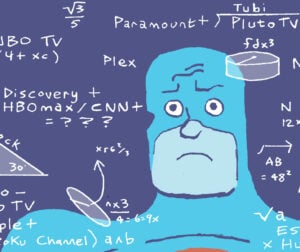WB is giving up the D. And vice versa, of course.
As was first announced back in June, the recently merged Warner Brothers Discovery (seriously, 2022 was only three years ago) will be separating back out into two independent, publicly traded companies.
The split is expected to happen sometime in mid-2026, WBD CEO David Zaslav told investors during the company’s second quarter earnings call on Thursday.
“We have taken a short-term financial hit for some real value that’s going to flow through,” said Chief Financial Officer Gunnar Wiedenfels, who will take on the role of Discovery Global’s CEO next year.
In the meantime, however, at least the current conglomerates’ earnings are looking OK.
Total revenue for the quarter was $9.8 billion, up only 1% year over year from the last Q2 quarter total of $9.7 billion – which is modest, but at least in line with company expectations.
Here comes the revenue
According to WBD’s earnings statement, most of that revenue increase is coming from content, not advertising.
Content revenue increased 16% due to significantly higher box office revenues. This past quarter, said Zaslav, Warner Brothers became the first studio to open five consecutive films with domestic box office revenue of over $45 million. (That would be “Minecraft,” “Sinner,” “The Accountant 2,” “Final Destination: Bloodlines” and “F1.”)
Within that, streaming revenue is up to $2.8 billion, compared to $2.6 this time last year, at an increase of 8%.
Overall advertising revenue dropped 10% to $2.2 billion, but not because the ad-supported streaming memberships aren’t doing well; it was because of a decline in domestic liner audiences.
Advertising revenue was down for global linear networks, too, from just over $2.2 billion to under $2 billion for a decrease of 13%.
But streaming ad revenue, although smaller, increased 17%, from $240 million in 2024 to $282 million in 2025 – primarily due to an increase in ad-lite subscribers, said WBD.
Overall, the company gained 3.4 million streaming subscribers for HBO Max in Q2 for a net total of 125.7 million.
Going to the Discovery Zone
Seeing all these numbers makes the upcoming divorce just a little bit less ridiculous – from the perspective of someone like David Zaslav, at least.
After all, all the studios, streaming platforms and licensing agreements that are making the company money right now come predominantly from the WB side; all the challenges that come with running linear TV networks are on the Discovery Global side.
But that also means WB will be giving up a large share of its domestic sports content, which has generally been seen as an industrywide bright spot in an otherwise declining linear TV market for advertisers.
“You know, we love the sports portfolio that we have,” said Wiedenfels. “And it’s going to be even more important as we look at Discovery Global as a separate, standalone entity.”
Discovery Global will also have its own streaming platforms in the form of Discovery+, The Bleacher Report and CNN’s new upcoming service (not to be confused with their previous attempt, CNN+, which lasted less than a month into the WBD merger).
“I do believe that there are very significant pockets of growth and opportunity,” said Wiedenfels. “We’ll work really hard over the next half year here to identify those and deliver what I think is going to be a business with much more longevity than what the market sees right now.”












